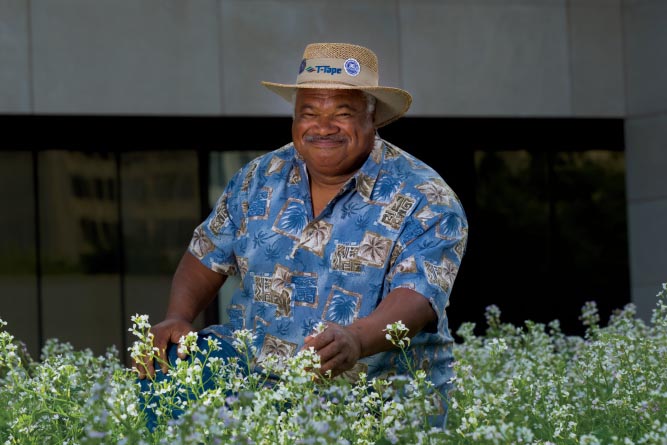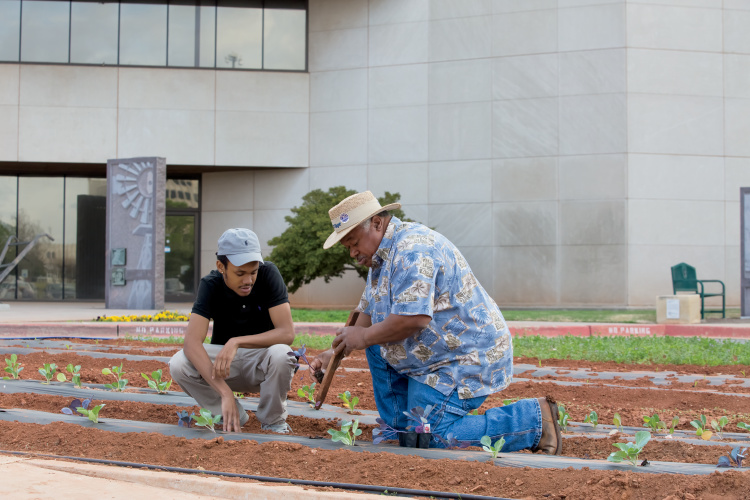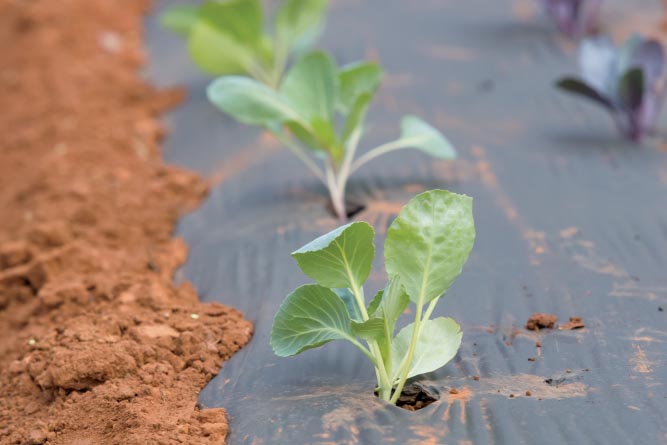Home > Oklahoma > Oklahoma Ag Education > Oklahoma Department of Ag Garden Provides Fresh Food, Ag Education
Oklahoma Department of Ag Garden Provides Fresh Food, Ag Education

As you walk up to the Oklahoma Department of Agriculture, Food and Forestry (ODAFF) building, you are greeted by a flourishing garden. This living patch was once just covered in Bermuda grass, perennial shrubs and bushes maintained by grounds crews, but when budget cuts in 2010 forced ODAFF to scale back, a silver lining arose, and the garden was born.
“The following year, Secretary and Commissioner of Agriculture Jim Reese came into the office and created the ODAFF Demonstration Project Garden that we see today,” says Micah Anderson, market coordinator of the department’s Plasticulture Program. “A gardening committee was created within the agency and volunteers from virtually all divisions donate their time and effort in helping plan and maintain the garden.”
The garden’s different sections focus on crops or plants grown for different purposes in Oklahoma. Anderson says the idea is to showcase specific crops and commodities the state is known for.
 For example, row crops such as peanuts, soybeans and cotton occupy one section of the garden, while fruits, vegetables and other ornamentals claim another. He adds that there are also seasonal plants to attract pollinators and make the garden visually appealing.
For example, row crops such as peanuts, soybeans and cotton occupy one section of the garden, while fruits, vegetables and other ornamentals claim another. He adds that there are also seasonal plants to attract pollinators and make the garden visually appealing.
“Much like production agriculture, garden crops are rotated throughout the growing season to give employees and visitors to the agency a sense of agriculture’s routine flow through the year,” Anderson says. “It also gives the gardening committee opportunities to demonstrate unique crops and commodities, such as purple sweet potatoes, brown cotton and burgundy okra.”
A Firsthand Look
Highlighting these important commodities is a way to make a simple garden mean so much more – it’s a teaching tool for consumers as well as a reminder for ODAFF employees. Anderson says people from across the state, country and even the world – including guests from India, China and Africa – have visited the garden to learn more about Oklahoma agriculture and how to grow their own food. “Some of the volunteer labor we get are people who are merely interested in learning how to grow their own food and basic skills needed for gardening,” he adds.
“We have implemented cover crops in the winter as we are able to, including crimson clover, winter peas and radishes. This helps keep the soil healthy during the winter,” Secretary and Commissioner Reese says. “Micah and the committee do a great job thinking creatively and educationally. They have demonstrated heirloom crops, cover crops, potatoes in tires and straw, cumin, stevia, and many other unconventional crops and cropping practices. We have learned new things through this garden.”
 Anderson says that’s one of the benefits of the garden – being able to teach techniques on a smaller scale. “Skills and techniques such as crop rotation, soil testing, irrigation and fertilization are just a few that can be taught in this small garden plot,” he says. “People learn that they can turn even inferior red clay soil into a productive garden plot with hard work and good management practices.”
Anderson says that’s one of the benefits of the garden – being able to teach techniques on a smaller scale. “Skills and techniques such as crop rotation, soil testing, irrigation and fertilization are just a few that can be taught in this small garden plot,” he says. “People learn that they can turn even inferior red clay soil into a productive garden plot with hard work and good management practices.”
He adds ODAFF has also used the space to showcase its Plasticulture Program, where plastic coverings are used to help grow certain crops, providing weed control, water conservation, reduction in nutrient leaching and more. “It gives visitors a firsthand look at the technology,” he says.
Anderson says that for the future, the main goal is to keep the area productive and attractive to anyone interested in Oklahoma agriculture. The committee plans to produce edible mushrooms and has planted more flowers that will attract honeybees for healthy pollinators.



